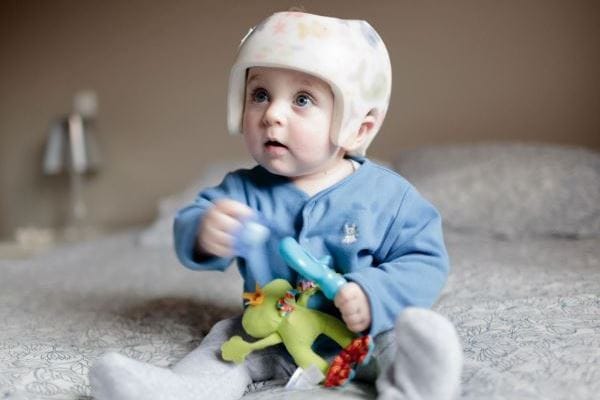The diagnosis of a serious neurological disorder is sometimes as simple as looking at your baby's skull.
Posted
by Featured Provider Nicholas Wetjen on Tuesday, September 29, 2020

One of your first concerns as a parent comes when you first hold your newborn baby. They’re so soft and squishy. You worry that a poor holding technique will cause permanent damage.
But a baby’s soft body and especially, their soft head, are what makes the miracle of childbirth possible. A skull cap quickly covers their cone-shaped head, formed by a laborious journey through the birth canal. In a short time, their bodies develop and their heads take shape.
If you don’t see the familiar shape of a normal human head after a few months, it could be a sign that your child was born with a rare but fixable birth defect: craniosynostosis.
What is craniosynostosis?
Craniosynostosis is a condition where a baby’s soft head closes too early. And it happens before the brain is fully formed, causing the skull to change its shape to accommodate the developing brain.
“You have multiple bones that make up your head. But they are not fused together when you are born. Your head can sort of stretch to get through the birth canal and allow for the brain to grow,” explains Nicholas M. Wetjen, MD, a pediatric neurosurgeon at The Iowa Clinic. “When one of the sutures that connects the bones grows together prematurely, it results in abnormal head shape.”
Craniosynostosis is a birth defect that affects one in every 2,500 babies born in the United States. While rare, it’s something you want to catch early and keep an eye out for in the first several months of your child’s life.
“This is something that happens before the child is born. The suture fuses before birth and it becomes more obvious over time. In most cases, it’s noticeable soon after birth.”

Your Child’s Health Is Our #1 Priority, Too
Trust Central Iowa’s most experienced pediatric neurosurgeon, Dr. Nicholas Wetjen.
Meet Dr. Wetjen
What does craniosynostosis look like?
Fortunately, craniosynostosis symptoms are physical — signs that doctors and even parents can spot early on.
You may notice that there is no soft spot on your baby’s head. There could be a hard, raised edge at the site of the closed suture. Your child’s head may be slow to grow — or not grow at all — which becomes more noticeable over time. But the most noticeable sign of craniosynostosis is an abnormal head shape.
"With each individual suture, there's a characteristic head shape that goes along with it. In most cases you can make the diagnosis just by looking at the shape of the head. But we then confirm the diagnosis with a CT scan," says Dr. Wetjen.
There are four distinct baby head shapes that doctors look for to diagnose the four types of craniosynostosis:
1. Sagittal Synostosis: Long and Narrow
Sagittal synostosis is the most common type of craniosynostosis, evident by the long, narrow shape of a baby’s head. The sagittal suture connects the two runs right down the middle of the head, connecting the parietal bone on each side of the cranium. When it closes too soon, the brain can only extend to the front and back of the head, creating an elongated head shape.
2. Coronal Synostosis: Flat Forehead
A baby with a flat forehead on one side may have coronal synostosis, the second most common type of craniosynostosis. There are two coronal sutures, one on the left and one on the right, that connect the frontal bone behind the forehead to two parietal bones on top. When one of the sutures closes early, the forehead flattens and can cause the eye socket to raise up and the nose to pull toward the side of the fusion.
3. Bicoronal Synostosis: Broad and Short
In some complex craniosynostosis cases, both coronal sutures close early. Bicoronal synostosis is a form of coronal synostosis, but it has a separate, distinct head shape. The closure of both coronal sutures causes the whole forehead to flatten, making the baby’s head wider and shorter.
4. Lambdoid Synostosis: Flat Back of the Head
If the back of your baby’s head is flat, it could be a sign of lambdoid synostosis. The lambdoid suture on the backside of the head runs between the occipital bone and the two parietal bones on top of the skull. It’s closing restricts the head from extending further backward.
This type of craniosynostosis is rare, so a flat back of the head is more likely a sign that your baby spends a lot of time on their back, causing their soft head to flatten out.
5. Metopic Synostosis: Triangular
There’s another suture on the front of the head: the metopic suture. Starting at a baby’s nose, it runs to the top of the head where it connects to the sagittal suture. A premature closure of the metopic suture gives a baby a triangle-shaped head. The front of their skull is narrow while the back is broad. Like lambdoid synostosis, metopic synostosis is quite rare.
How is craniosynostosis treated?
“There are two different ways to treat it — both are surgeries. One is with an endoscope, which is a minimally invasive approach. And that’s done between three and six months of age,” says Dr. Wetjen. “Then there’s cranial vault remodeling, which is done closer to anywhere between nine and 15 months.”
The minimally invasive approach is the preferred method for most parents and providers. The procedure requires a smaller incision and a shorter hospital stay. There’s also less blood loss and risk for complications. After the surgery, the baby must wear a head-shaping helmet to help guide the skull back to a normal shape.
“Cranial vault remodeling is a longer, more serious operation with greater risks. Children generally end up needing to stay in intensive care for a night or two and in the hospital for three or four days total,” says Dr. Wetjen. “The results are just as good as the endoscopic approach and no helmet is needed afterward. We mostly perform this surgery when the diagnosis is made after a baby is six months old.”
When should I worry about my baby’s head shape?
Babies’ heads are so soft that other things can affect the shape. Some may only be temporary changes while others, like craniosynostosis, can lead to permanent issues if untreated. While not all head shapes are as serious, it’s always something you should ask about as soon as you have concerns.
Your pediatrician can help answer any questions about your baby’s head shape — or refer you to a pediatric neurosurgeon who can. They can tell if it’s a characteristic shape of craniosynostosis or a misshapen head caused by your baby preferring to sleep on one side of their head.
“Sometimes it’s just because they have a soft head and not something caused by fusion of the bone,” Dr. Wetjen explains. “Positional plagiocephaly is quite common — as many as 40% of kids have at least a mild case of it. And it’s kind of like putting a water balloon on a table. It sort of flattens along the side there.”
In most cases, positional plagiocephaly gets better with repositioning so that your child doesn’t lie on that side of the head. But in severe cases, helmet therapy is needed to shape the head, similar to treatment after endoscopic surgery to correct craniosynostosis.
“It’s important that if there’s a concern, talk to your provider,” says Dr. Wetjen. “We like to see kids as early as possible so that we can sort it out and have options for treatment.”
Meet This Featured Provider

Learn More About:
Neurological & Spinal Surgery,
Spine Center
Nicholas M. Wetjen, MD joined The Iowa Clinic after directing Pediatric Neurosurgery at the Mayo Clinic in Rochester, Minnesota for nearly ten years. He chose The Iowa Clinic because of the talented team of surgeons who provide exceptional neurosurgical care right here in his home state of Iowa.<... Read More
Accepting New Patients
Other Neurological & Spinal Surgery
Tags
- pediatric neurosurgery
- pediatrics